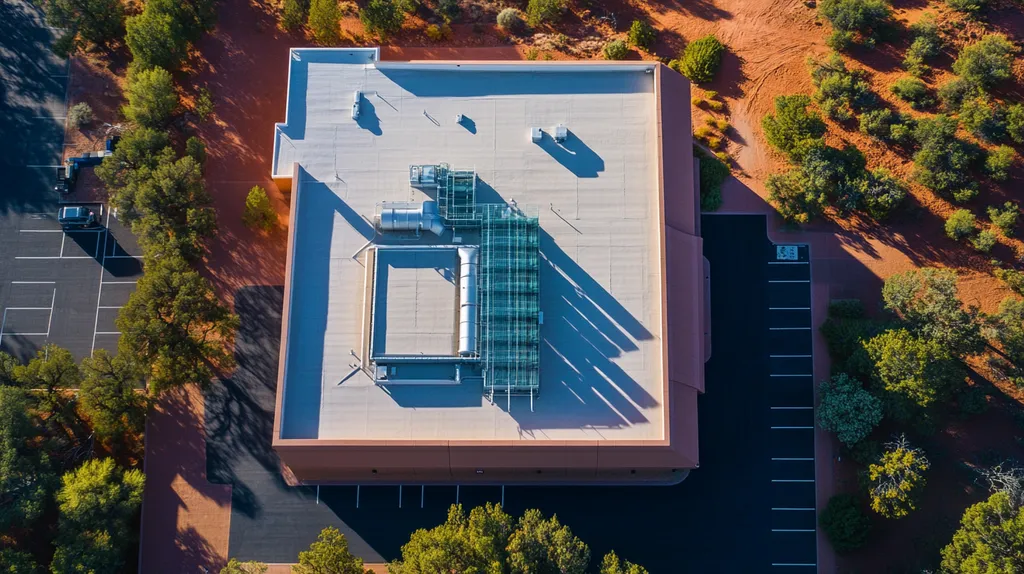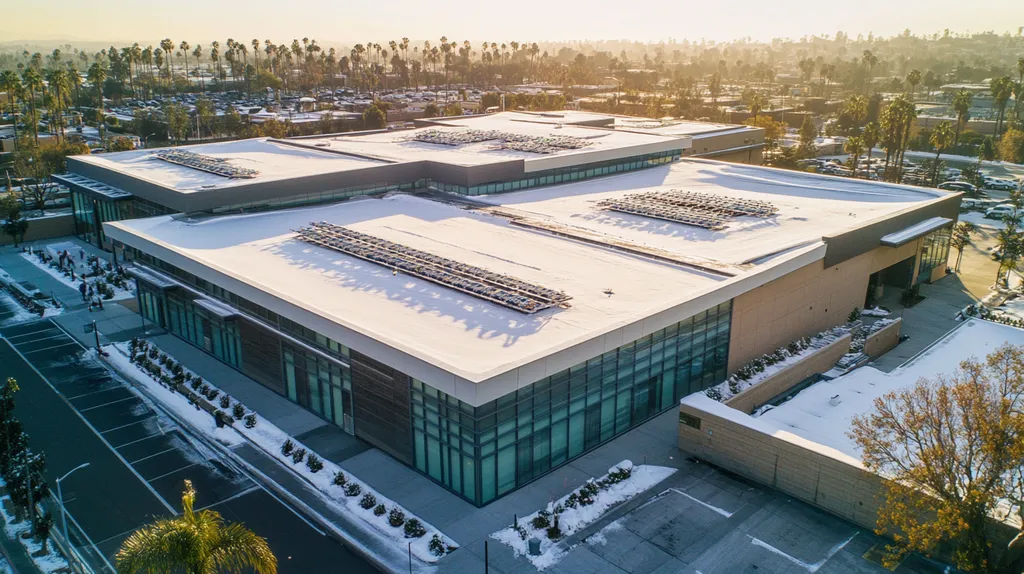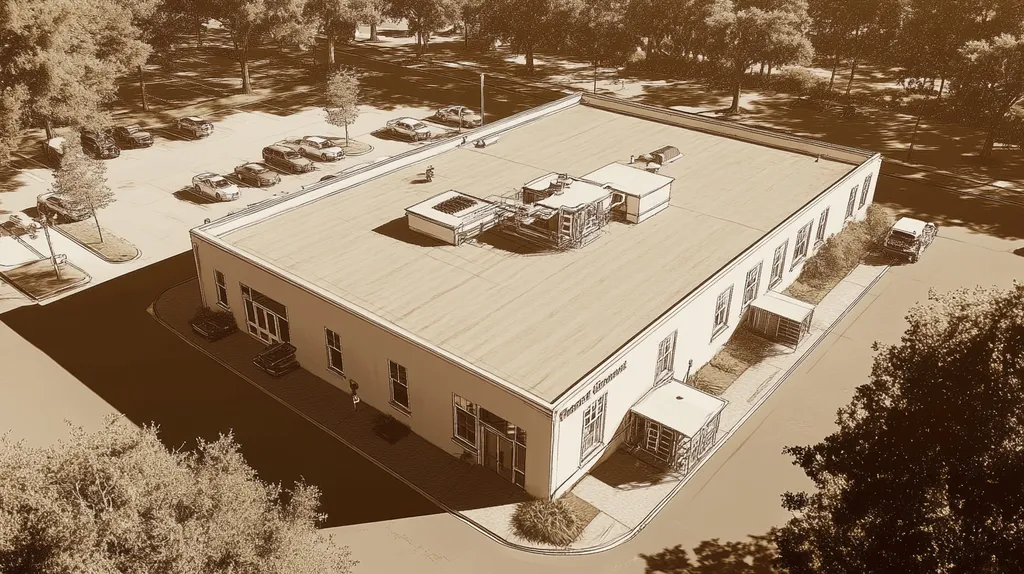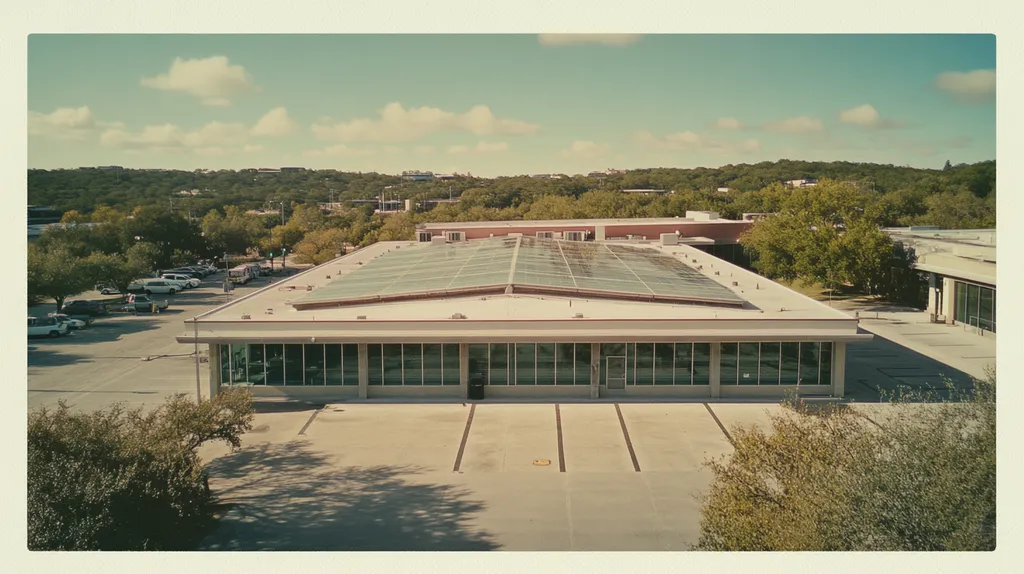Welcome to today’s Battle Royale featuring two roofing heavyweights: “Cool Roofs” in the east corner versus “Energy Star Rated Asphalt Shingles” in the west!
Tonight’s showdown pits these contenders against each other across six punishing rounds designed to test every aspect of their performance for Expected Return on Investment.
At stake? Millions in potential costs, decades of building protection, and the critical performance demands of modern commercial and industrial facilities.
Our professional judging panel will evaluate each round on technical merit, real-world performance, and value delivery. After all six rounds, we’ll declare our ultimate champion.
Ladies and gentlemen, facility managers and building owners… it’s time to rumble!
ROUND 1: INITIAL COSTS & INSTALLATION
When evaluating roofing systems, the initial investment often becomes a critical decision point for property owners and facility managers. With energy costs continuing to climb and sustainability requirements becoming stricter, choosing between cool roofs and Energy Star rated asphalt shingles requires careful analysis of upfront costs, installation requirements, and project logistics.
Material Expenses
Energy-efficient roofing materials represent a significant portion of project budgets, with costs varying widely based on specific product selections and coverage area requirements. Cool roofs typically command premium pricing due to their specialized reflective materials and advanced engineering.
Energy Star rated asphalt shingles feature special granules that increase their Solar Reflectance Index (SRI) number, offering an affordable entry point into energy-efficient roofing. These shingles provide durability with lifespans ranging from 20 to 50 years. (source: Modernize)
Despite their higher initial cost, cool roofs often deliver superior energy performance and greater long-term savings. For material value proposition, the ADVANTAGE goes to cool roofs.
Installation Complexity
Installation procedures directly impact labor costs and project risk factors. Cool roof systems frequently require specialized application techniques and specific environmental conditions for proper installation, potentially increasing both complexity and cost.
Energy Star rated asphalt shingles follow standard installation practices familiar to most roofing contractors. Their conventional installation methods reduce the likelihood of application errors while maintaining competitive labor costs.
With lower technical requirements and broader contractor availability, Energy Star rated asphalt shingles offer clear benefits. For installation complexity, the ADVANTAGE belongs to Energy Star rated asphalt shingles.
Project Timeline
Project duration affects both direct costs and operational disruption. Cool roof installations typically require more precise scheduling and longer installation windows due to their technical requirements and weather sensitivity.
Energy Star rated asphalt shingle projects generally progress more quickly, following established installation patterns. Their faster completion helps minimize facility disruption and reduces exposure to weather-related delays.
The streamlined installation process of Energy Star rated asphalt shingles provides clear scheduling benefits. For project timeline efficiency, the ADVANTAGE goes to Energy Star rated asphalt shingles.
ROUND 1 WINNER: ENERGY STAR RATED ASPHALT SHINGLES
ROUND 2: DURABILITY & LIFESPAN
When evaluating roofing investments, durability and lifespan directly impact total ownership costs and building protection. Modern roofing solutions must withstand increasingly extreme weather patterns while maintaining their energy-efficient properties over decades of service.
Property owners face a critical choice between proven traditional materials and innovative solutions designed for longevity. The right decision can mean the difference between frequent replacements and sustained performance spanning multiple decades.
Weather Resistance
Cool roofs utilize advanced materials engineered specifically for extreme temperature variations and UV exposure. Their reflective surfaces and specialized composition help prevent thermal shock, reducing material fatigue and extending service life.
These systems demonstrate superior resistance to cracking, blistering, and surface degradation compared to traditional materials. The enhanced durability translates to fewer repairs and more consistent performance over time.
Energy Star rated asphalt shingles rely on conventional materials with added reflective granules. While these additions improve energy performance, they don’t fundamentally change the underlying material limitations of asphalt in extreme conditions.
When faced with severe weather cycles, these shingles can experience accelerated wear and granule loss. For weather resistance, the ADVANTAGE goes to cool roofs.
Material Longevity
Cool roof systems typically maintain their performance characteristics for 20-30 years with proper maintenance. Their specialized materials resist degradation from UV exposure while maintaining reflective properties throughout their service life.
Energy Star rated asphalt shingles can last 15-25 years under optimal conditions. However, their energy-efficient properties may diminish over time as reflective granules wear away.
The extended performance period of cool roofs offers significant value for property owners. Energy-efficient roofing can increase property value by 1-6% while generating substantial energy savings over its lifespan. (source: Scott Bauer Roofing)
For material longevity, the ADVANTAGE belongs to cool roofs.
Maintenance Requirements
Cool roof systems generally require minimal maintenance beyond regular inspections and basic cleaning. Their durable construction and resistance to environmental damage reduce the need for frequent repairs or restoration.
Simple maintenance procedures help preserve their reflective properties and structural integrity. Most issues can be addressed through routine preventive care rather than major repairs.
Energy Star rated asphalt shingles demand more frequent inspection and maintenance to ensure optimal performance. Their granulated surface requires regular cleaning and may need periodic restoration to maintain energy efficiency.
Repairs become more common as these shingles age, particularly in areas experiencing significant temperature swings. For maintenance requirements, the ADVANTAGE goes to cool roofs.
ROUND 2 WINNER: Cool Roofs
ROUND 3: PERFORMANCE FACTORS
In today’s climate-conscious market, roofing performance directly impacts both operating costs and environmental compliance. Property owners face increasing pressure to maximize energy efficiency while maintaining strict budget controls. Understanding how different roofing systems perform across key metrics becomes crucial for making sound investment decisions.
Heat Management Capabilities
Heat management effectiveness directly influences building cooling costs and occupant comfort. Cool roofs excel in this area, reflecting up to 80% of solar radiation and reducing peak roof temperatures by up to 50°F compared to traditional materials.
These systems maintain their reflective properties even in extreme heat conditions, providing consistent performance throughout the summer months. Their specialized coatings and materials work together to minimize heat absorption and transfer.
Energy Star rated asphalt shingles offer improved heat management over standard shingles through their reflective granules. However, their basic composition still absorbs more heat than cool roof systems, resulting in higher interior temperatures.
For heat management capabilities, the ADVANTAGE goes to cool roofs.
Energy Performance
Building energy consumption represents a major operational expense that directly impacts return on investment. Cool roofs demonstrate superior energy performance by significantly reducing cooling loads, particularly during peak demand periods.
These systems can slash cooling costs by 20-40% in commercial buildings, making them especially valuable in warm climates. Their performance remains relatively stable throughout their service life.
Energy Star rated asphalt shingles provide moderate energy savings compared to conventional shingles. However, their energy-efficient properties may diminish over time as reflective granules wear away.
For energy performance, the ADVANTAGE belongs to cool roofs.
Climate Adaptability
Regional climate conditions significantly influence roofing system effectiveness. Cool roofs demonstrate exceptional adaptability across various climate zones, performing particularly well in areas with high cooling demands and intense solar exposure.
These systems help combat urban heat island effects while reducing local air temperatures. Their reflective properties work year-round to regulate building temperature.
Energy Star rated asphalt shingles perform adequately in moderate climates but may struggle in extreme conditions. Their effectiveness can vary significantly based on local weather patterns and seasonal changes.
For climate adaptability, the ADVANTAGE goes to cool roofs.
ROUND 3 WINNER: Cool Roofs
ROUND 4: MAINTENANCE REQUIREMENTS
For commercial and industrial property owners, maintenance requirements directly impact the total cost of ownership and long-term return on investment. Studies show that preventive maintenance can extend a roof’s lifespan by up to 50%, while neglect can cut it in half. Understanding these maintenance demands becomes crucial when comparing cool roofs to Energy Star rated asphalt shingles.
Routine Inspection Requirements
Cool roofs demand systematic inspections focused primarily on surface cleanliness and reflectivity preservation. These inspections typically occur bi-annually, with additional checks after severe weather events.
Professional evaluations concentrate on maintaining the roof’s reflective properties, which directly impact energy performance. Simple cleaning procedures and basic repairs often restore optimal functionality without specialized expertise.
Energy Star rated asphalt shingles require more frequent inspections, particularly as they age. These examinations must assess granule loss, shingle integrity, and potential moisture infiltration points.
Due to their simpler maintenance profile and longer inspection intervals, the ADVANTAGE goes to cool roofs.
Cleaning and Preventive Care
Cool roof systems need regular cleaning to maintain their reflective properties. Most maintenance involves removing debris, washing surfaces, and occasional recoating to preserve energy efficiency.
A new roof can retain 85% of its value upon resale when properly maintained, making ongoing care a crucial investment consideration. (source: VPN Construction)
Energy Star rated asphalt shingles demand more intensive cleaning protocols to prevent algae growth and preserve granule coating. Their textured surface tends to trap debris and requires specialized cleaning methods to avoid damage.
With simpler cleaning requirements and fewer specialized procedures, the ADVANTAGE belongs to cool roofs.
Repair Procedures
Cool roof repairs typically focus on maintaining surface integrity and reflective properties. Most issues can be addressed with patch repairs or localized recoating, minimizing disruption to building operations.
These systems generally require fewer emergency repairs due to their resistant properties and uniform surface construction. When repairs are needed, they can often be completed quickly with standard materials.
Energy Star rated asphalt shingles frequently need more complex repairs involving shingle replacement and surrounding area assessment. Their granulated surface makes matching repairs more challenging, often requiring larger section replacements.
Given their straightforward repair procedures and lower emergency intervention rates, the ADVANTAGE goes to cool roofs.
ROUND 4 WINNER: Cool Roofs
ROUND 5: SUSTAINABILITY CREDENTIALS
Environmental regulations and market demands are reshaping commercial roofing decisions. With carbon reduction targets becoming stricter and energy costs continuing to rise, sustainability credentials now directly impact both compliance and operational costs. Property owners must evaluate how different roofing systems align with current and future environmental requirements.
Environmental Impact
Roofing choices significantly influence a building’s environmental footprint through energy consumption, urban heat island effects, and material lifecycle impacts. Modern facilities must balance immediate operational needs with long-term environmental responsibility.
Cool roofs deliver superior environmental performance through advanced reflective technologies and reduced cooling demands. Their specialized surfaces minimize heat absorption while helping moderate local temperatures, particularly in dense urban environments.
Energy Star rated asphalt shingles offer improved environmental performance compared to standard shingles but fall short of cool roof capabilities. Their granulated surface provides moderate heat reflection but cannot match the comprehensive environmental benefits of cool roof systems.
For environmental impact reduction, the ADVANTAGE goes to cool roofs.
Material Sustainability
Material composition and manufacturing processes directly affect a roof’s overall environmental impact. Sustainable roofing must consider both production methods and end-of-life disposal options.
Cool roof systems typically incorporate materials designed for recyclability and minimal environmental impact. Their components often include recycled content and can be reclaimed at the end of their service life, reducing landfill impact.
Energy Star rated asphalt shingles present greater recycling challenges due to their composite construction. While some components can be recycled, their petroleum-based materials and complex manufacturing process increase their environmental footprint.
For material sustainability, the ADVANTAGE belongs to cool roofs.
Green Building Certification
Sustainability certifications increasingly influence property values and tenant decisions. Building owners must consider how roofing choices affect their ability to achieve and maintain green building credentials.
Cool roofs contribute significant points toward major green building certifications through their energy efficiency and heat island mitigation properties. Their performance characteristics align well with evolving sustainability standards and environmental regulations.
Energy Star rated asphalt shingles provide basic certification benefits but may not qualify for advanced sustainability credits. Their moderate environmental performance can limit a building’s ability to achieve higher certification levels.
For green building certification potential, the ADVANTAGE goes to cool roofs.
ROUND 5 WINNER: Cool Roofs
ROUND 6: SPECIALIZED APPLICATIONS
As building technologies evolve and energy codes become stricter, specialized roofing applications have become critical decision factors for property owners. The right choice between cool roofs and Energy Star rated asphalt shingles can mean the difference between optimal performance and costly underperformance in specific use cases.
Understanding how these systems perform under unique conditions directly impacts both initial returns and long-term value. Property owners must carefully evaluate their specific application requirements to maximize their roofing investment.
Industrial Process Facilities
Industrial facilities with high heat-generating processes require roofing systems that can effectively manage extreme temperature differentials. These environments often experience significant thermal stress from both internal operations and external conditions.
Cool roofs excel in these applications by efficiently reflecting solar radiation while helping dissipate internal heat. Their specialized materials maintain performance even under extreme thermal loads, reducing cooling requirements and extending HVAC system life.
Energy Star rated asphalt shingles struggle to match this performance level in high-heat industrial settings. Their granulated surface provides moderate reflection but cannot effectively manage the combined thermal loads typical in process facilities.
For industrial process applications, the ADVANTAGE goes to cool roofs.
Data Center Applications
Data centers demand precise temperature control to maintain optimal equipment performance and energy efficiency. These facilities operate 24/7 with constant cooling requirements, making roofing performance crucial for operational costs.
Cool roofs provide superior heat management capabilities that directly complement data center cooling systems. Their consistent performance helps maintain stable interior temperatures while reducing the load on critical cooling infrastructure.
Energy Star rated asphalt shingles offer adequate performance for smaller facilities but may not provide sufficient thermal management for large-scale data operations. Their moderate reflective properties cannot match the heat reduction capabilities needed in these demanding environments.
For data center applications, the ADVANTAGE belongs to cool roofs.
Cold Storage Facilities
Cold storage facilities face unique challenges in maintaining consistent interior temperatures while managing external heat loads. These specialized buildings require roofing systems that can effectively support their intensive cooling requirements.
Cool roofs can recoup 60-70% of their installation costs through energy savings and improved facility performance, particularly in temperature-critical applications. Their reflective properties help minimize heat gain, reducing the strain on refrigeration systems. (source: Revive Real Estate)
Energy Star rated asphalt shingles provide basic thermal protection but cannot match the performance level required for optimal cold storage operation. Their limited heat reflection capabilities may result in higher cooling costs and increased system wear.
For cold storage applications, the ADVANTAGE goes to cool roofs.
ROUND 6 WINNER: COOL ROOFS
AND THE WINNER IS…
After six grueling rounds of technical evaluation, we have our verdict…
In a stunning display of technical superiority, COOL ROOFS emerge as our undisputed champion, claiming victory in five out of six rounds! This roofing heavyweight dominated the competition with exceptional performance in durability, energy efficiency, maintenance simplicity, sustainability credentials, and specialized applications.
The champion’s superior heat management capabilities, extended service life, and impressive environmental credentials proved unstoppable in the commercial and industrial arena. With potential energy savings of 20-40% and service life pushing 30 years, cool roofs delivered a knockout combination of immediate returns and long-term value.
However, don’t count Energy Star rated asphalt shingles out completely. Their victory in Round 1 highlights their strength as a cost-effective solution for properties with straightforward requirements and moderate climate conditions. Their familiar installation methods and lower initial costs make them a solid contender for many standard commercial applications.
*Important Notice: Every building presents unique challenges and opportunities. Local climate conditions, specific property characteristics, and operational requirements significantly influence roofing performance. This analysis provides general guidance but cannot account for all variables. Consult qualified roofing professionals to evaluate your specific situation.*
Ladies and gentlemen, in the high-stakes world of commercial roofing, remember: The true champion is the system that best matches your building’s specific requirements while delivering maximum return on investment. Choose your contender wisely!
FREQUENTLY ASKED QUESTIONS
Q. What are the initial costs for commercial roofs?
A. The initial costs for commercial roofing vary significantly depending on the material chosen. Cool roofs typically have higher upfront costs due to specialized materials, while Energy Star rated asphalt shingles are often more affordable. However, investing in energy-efficient options can lead to long-term savings on energy bills.
Q. How long do industrial roofs typically last?
A. The lifespan of industrial roofs can vary, but cool roofs often last 20-30 years with proper maintenance, while Energy Star rated asphalt shingles may last between 15-25 years. Understanding the longevity of these materials is crucial for informing your roofing investment decisions.
Q. Which roofing system performs better for energy efficiency?
A. Cool roofs significantly outperform Energy Star rated asphalt shingles regarding energy efficiency. They reflect more solar radiation, leading to reduced cooling costs and increased energy savings over time. Understanding the energy performance of each system can help in making a more informed investment choice.
Q. What are the maintenance requirements for commercial roofs?
A. Cool roofs typically require minimal maintenance, focusing on regular inspections and cleaning to preserve their reflective properties. In contrast, Energy Star rated asphalt shingles demand more frequent inspections and maintenance to ensure optimal performance and reduce granule loss. Understanding these requirements can help avoid unexpected costs.
Q. How do roofing options affect sustainability credentials?
A. Cool roofs generally contribute more towards achieving sustainability credentials due to their energy-efficient design and heat management capabilities. They help reduce the urban heat island effect and lower energy consumption. Energy Star rated asphalt shingles offer some benefits but may not fully support advanced sustainability goals.
Q. Are cool roofs suitable for cold storage facilities?
A. Yes, cool roofs are highly suitable for cold storage facilities. They effectively minimize heat gain, assisting in maintaining consistent interior temperatures and reducing cooling demands. This efficiency can lead to significant energy savings, making them an excellent investment for such applications.
Q. What factors should I consider when choosing a commercial roof?
A. When choosing a commercial roof, consider initial costs, durability, energy performance, and maintenance requirements. Additionally, evaluate how each type aligns with sustainability goals and other specialized applications. Making an informed choice requires understanding each roofing system’s long-term benefits and challenges.











